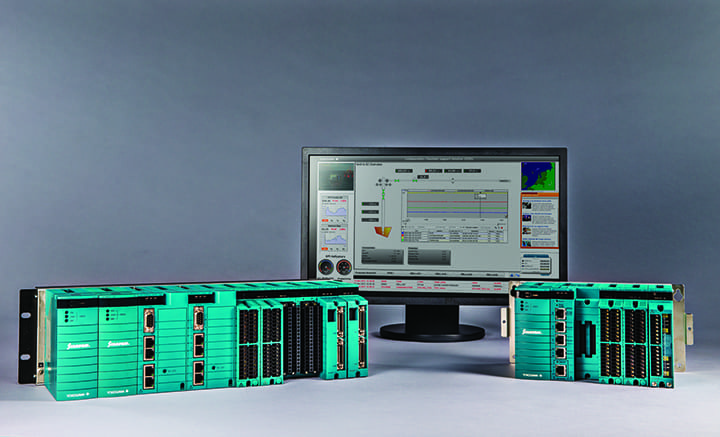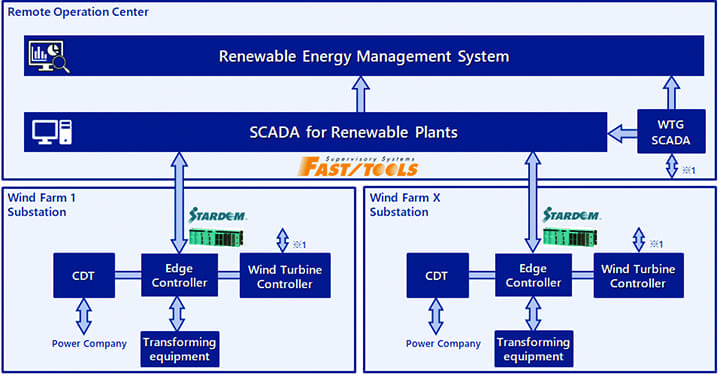Internet of Things (IoT)-based energy management systems centered around edge controllers provide the functionality required to match renewable energy output with power requirements.
Traditional baseload power generation units can be connected to and support the grid in a relatively straightforward manner. This is because they typically generate significant amounts of power with predictable and easily variable output, while being closely monitored and controlled by skilled and experienced operators. Each unit operates with onsite staff in most cases, so any problems can be addressed quickly.
On the other hand, renewable energy sources–such as biomass, geothermal, solar, and wind–present a host of challenges when it comes to matching output to demand. Renewables usually generate relatively small amounts of power on an intermittent basis, making it difficult to provide grid stability by matching output to demand. These facilities often operate in remote areas with limited or no staff onsite, compounding difficulties. However, these and other issues can be addressed by the intelligent application of sophisticated control and monitoring systems.
Issues Abound
The amount of power generated by each renewable generation source tends to rely heavily on environmental conditions and is therefore somewhat unpredictable from one moment to the next. Furthermore, power output can be difficult or impossible to control. For example, biomass facilities may have a stockpile of wood chips on hand, but the amount of power that can be generated for a given amount of fuel can vary widely due to inconsistent and unpredictable fuel quality. Geothermal facilities rely on natural phenomena, such as the size and capacity of the steam fields, while solar and wind farm power output is dependent on the weather conditions at the site.
Local power storage can help match renewable output to grid demand, but these technologies are relatively expensive (batteries and flywheels), very inefficient (pumped hydro and others), or both. Battery storage costs are beginning to fall and may allow for this storage technology to be applied more widely in the future, but batteries present other problems due to performance degradation over time, especially when required to charge and discharge frequently. When batteries inevitably degrade to the point where use is no longer practical, disposal is an issue because they contain hazardous materials.
Close coordination is therefore required among renewable plants and facilities, the grid, and power storage to balance output with demand. Unattended operation is often needed because it is not economically feasible to staff the hundreds or even thousands of remotely located sites generating renewable energy. This requirement creates corresponding issues as remote monitoring becomes a necessity, calling for a remote operation center (ROC) staffed by a few renewable energy experts leveraging sophisticated analysis and automation tools.
An ROC is typically where challenges of a mixed generation portfolio are addressed. Whether this function is performed internally or provided by a third party, leveraging a single interface to keep an eye–remotely–on all the varied assets helps improve performance and reliability. By taking on the responsibility of operating diverse assets and dispatching personnel to address issues at each facility, an ROC and its shared automation and asset management infrastructure maximizes operational value while driving down maintenance and other costs.
Connecting remote sites to an ROC requires sophisticated networking infrastructure. Designing, installing, and supporting this type of network is often cost prohibitive, so most implementations instead rely on the internet, which raises cybersecurity concerns.
There are a host of renewable power generation suppliers due to the wide variety of technologies, tremendous variation in rated power output, frequent innovations delivered by new entrants to the market, and other factors. There are no standards among these suppliers regarding the type of automation systems employed, and while there are some standards regarding digital communication protocols for the power industry, many suppliers of renewables install proprietary products, which may support standard protocols. Integration of these different automation systems is therefore required, an ongoing task as changes and updates to each automation system can generate new issues.
With natural cycles of new additions along with mergers and acquisitions, this mix of assets and control technology is unavoidable, presenting challenges for owners and operators. Portfolios consist of multiple vendor technologies, each with their own characteristics. Owners and operators have a mix of assets supplied by many different original equipment manufacturers (OEMs), and each facility typically has an automation system, and a supervisory control and data acquisition (SCADA) system.
Not only is this lack of standardization expensive to maintain, it can be difficult to efficiently integrate into enterprise operations. Each system must be maintained and updated, with each facility having its own unique solution. And in many cases, the same OEM solution deployed at different facilities will lack standard implementation details and software configuration.
Despite these issues, the share of power generated by renewables is expected to rise steadily over the next few decades, often to meet national targets. In Japan, for example, the goal is for 22% to 24% of the power supply to come from renewable energy by 2030. To meet these and similar goals worldwide, new automation solutions will be required.
IoT-Based Energy Management Systems Address Issues
Each renewable site can benefit by measurement, control, real-time monitoring, and Internet of Things (IoT)-based communication capabilities. Measurement is performed by a variety of instruments and sensors to determine electric current and voltage, flow rates, pressures, temperatures, levels, vibration readings, and other parameters. Technology to capture, monitor, and communicate this data is required at each site.
Each site also requires some type of local real-time control. As previously mentioned, automation system platforms and communication capabilities are not consistent from one type of renewable source to the next, requiring integration among automation systems. A relatively new type of automation component, typically referred to as an edge controller (Figure 1), is well-suited to provide this required functionality as one of the core components of an IoT-based energy management system (EMS).
 |
|
1. Edge controllers installed at remote renewable generating sites provide the functionality required for integration and communication. Courtesy: Yokogawa |
This edge control capability can be deployed for new and existing asset implementations. These controllers integrate with OEM automation technologies, effectively extending the capability of automation and SCADA systems that may not have been originally designed or envisioned to perform required functions.
Typically, existing automation systems will support various means of digital communications. Popular serial protocols such as Modbus RTU (remote terminal unit) allow a host of variables to be communicated between existing automation systems and an edge controller. More advanced protocols are supported by many automation systems and are usually Ethernet-based, providing higher bandwidth and greater speeds as compared to serial communications.
Whether acting as the main automation system or connecting to existing automation systems, an edge controller will provide the functionality required to monitor and control the local equipment, and to communicate with an ROC. As with all internet-based communications, cybersecurity concerns must be addressed, a detailed topic that will not be covered in this article other than to say there are national guidelines in most countries and regions for electrical infrastructure digital communications.
The ROC usually hosts a SCADA system, which connects to the edge controllers installed at each remote site. The SCADA system also integrates information regarding power demands from the grid, the power output from various generation resources, and the status of energy storage assets. Using information from all these sources, the SCADA system provides the required coordination among generation, demand, and power storage.
Edge controllers and a SCADA system combine to provide an IoT-based EMS to perform energy planning and performance management, and they can also add prediction optimization using big data and analysis algorithms. This functionality and data gathering are required to support the operations and management at both the facility and the business level. The following example shows how an EMS is used to coordinate power produced by a large wind firm with grid demand.
Wind Farm Use Case
Many wind farms have been constructed in Japan since 2000, and Yokogawa has been providing EMS solutions to these wind farms commencing in 2015 and continuing to the present. For example, a large wind farm in Japan uses an EMS based on Yokogawa's edge controllers and their SCADA solution. Yokogawa participated in the project as the system provider from the beginning of construction through to final commissioning.
Yokogawa supplied the following equipment and services:
- ■ e-RT3 real-time-OS-based or STARDOM controllers for monitoring and operation of substations and a switchyard, enabling remote operation and monitoring from the ROC. These controllers are used to monitor equipment status, process value readings, and alarms–and they communicate with the power utility, turbine controllers, and control switches.
- ■ FAST/TOOLS SCADA for supervisory facility monitoring and control. The SCADA system communicates with the substations, switchyard, and wind turbines at intervals of one second or less, and it displays readings and status. In addition to real-time monitoring, the SCADA system facilitates administrative tasks such as daily and monthly reporting.
- ■ System components consist of administrative servers, PC-based monitoring systems, and peripherals (Figure 2).
- ■ Network and cybersecurity architecture designed to support the local wind farm network and integration to the ROC, as well as secure connectivity to external third parties.
- ■ All associated engineering and on-site services to implement, test, and deliver the operational solution.
 |
|
2. This system architecture depicts deployment of an Internet of Things (IoT)-based management system for a wind farm in Japan. Courtesy: Yokogawa |
The entire system has been operating reliably since its installation, supplying clean power to the grid and helping Japan meets its renewable energy goals.
As renewable generation technologies continue to account for an increasing proportion of the global energy mix, the intermittent nature of these assets will present challenges for integration with the grid. However, these issues can be addressed by deploying the latest automation and IoT-based technologies that offer extensive functionality and advanced optimization capabilities, resulting in lower levelized cost of energy and more reliable operations.
–Tatsuya Yamaguchi is a manager with Yokogawa Electric Corp., where he leads the renewable energy business in the areas of measurement and control.
